Reduction of Friction of Metals Using Laser-Induced Periodic Surface Nanostructures
Abstract
:1. Introduction
2. Experimental Procedures
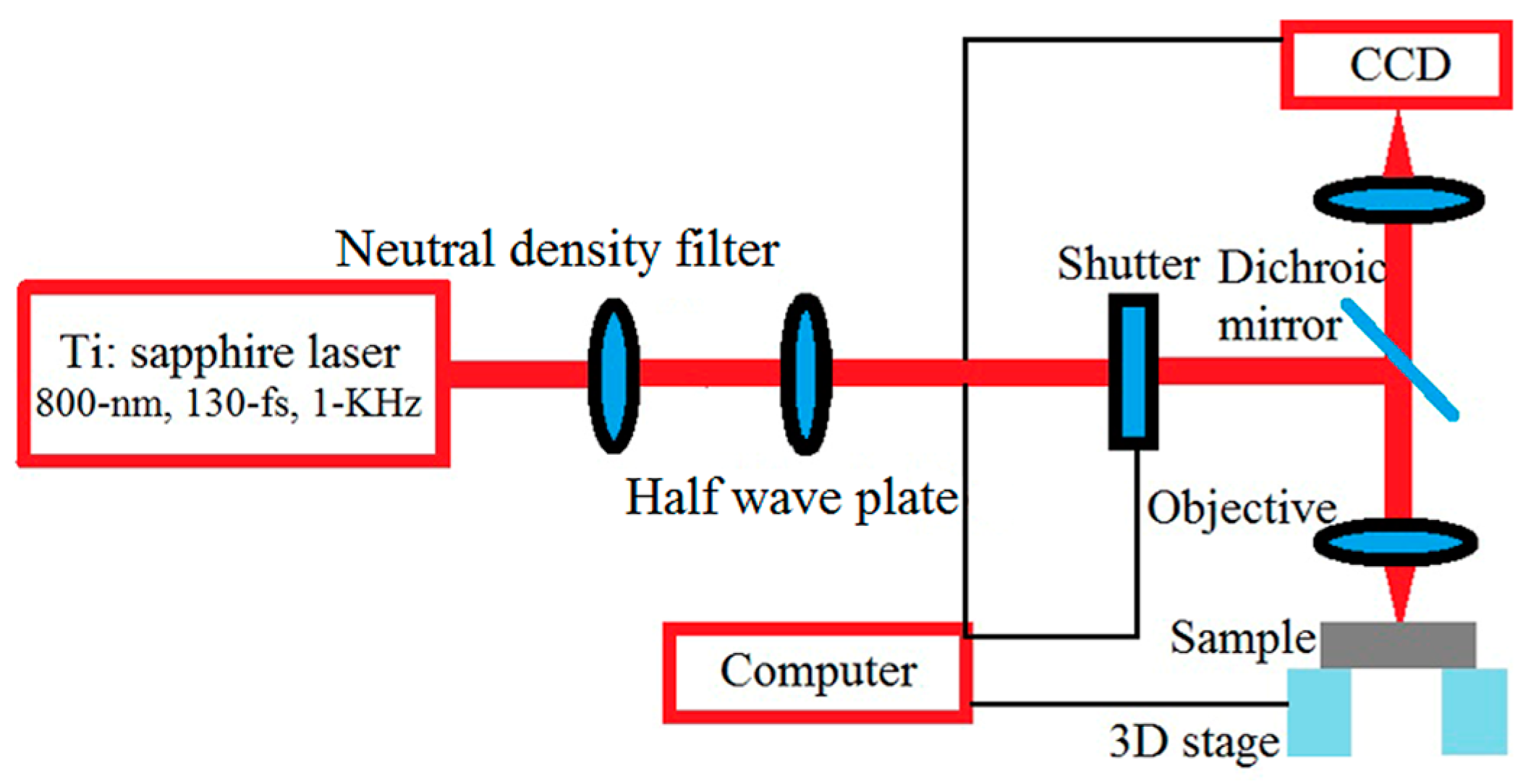
3. Results and Discussion
3.1. Laser Induced Periodic Surface Structures (LIPSS) of AISI 304 Steel
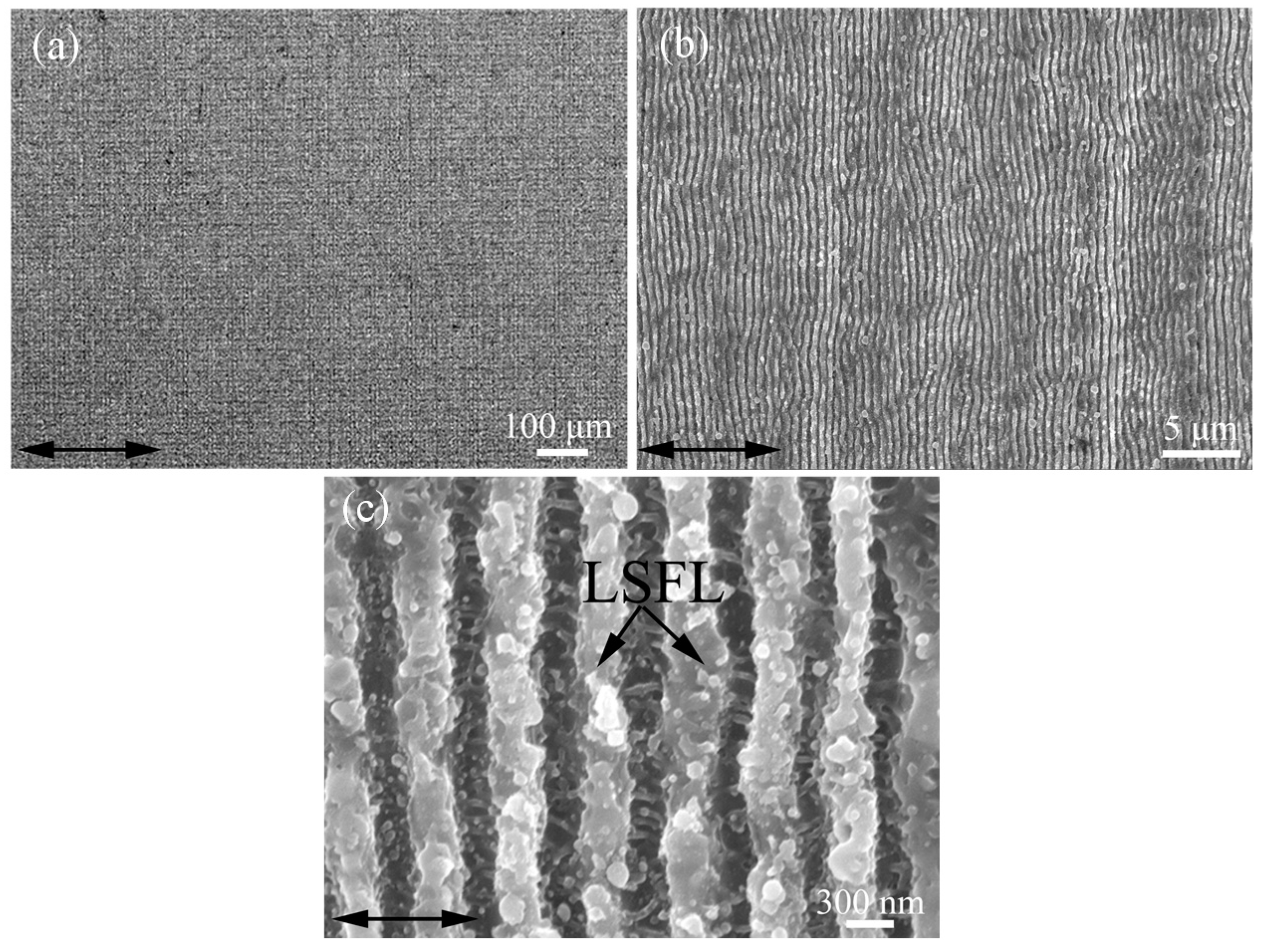
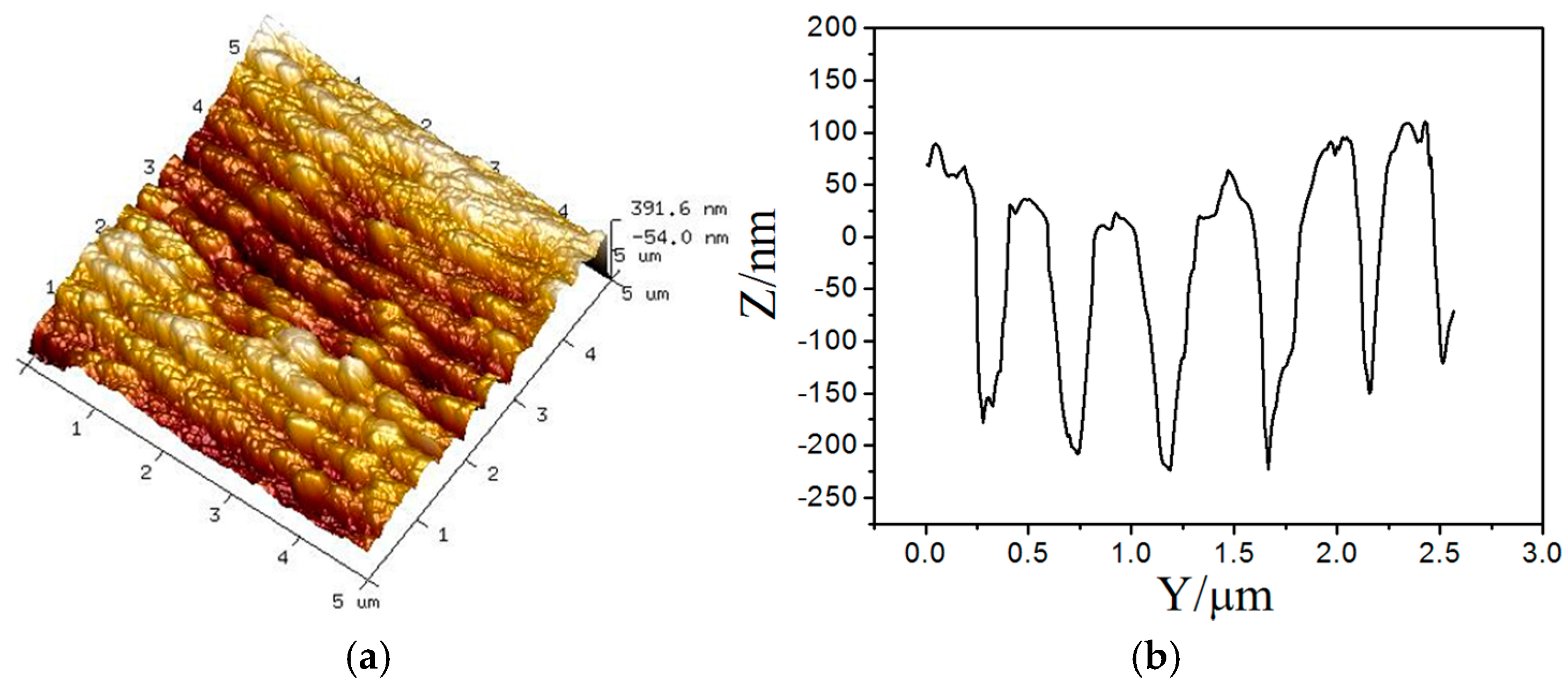
3.2. Effect of LIPSS on Tribological Properties Under Dry Conditions
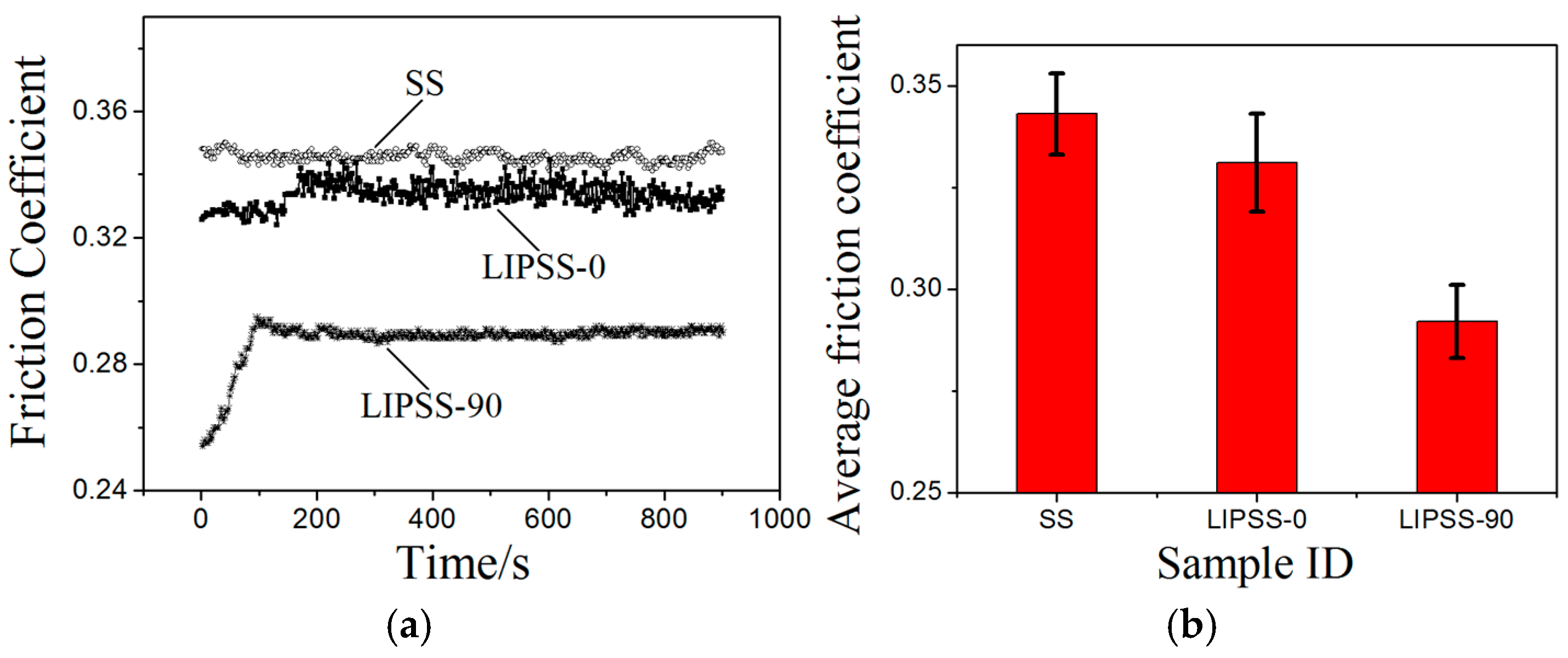
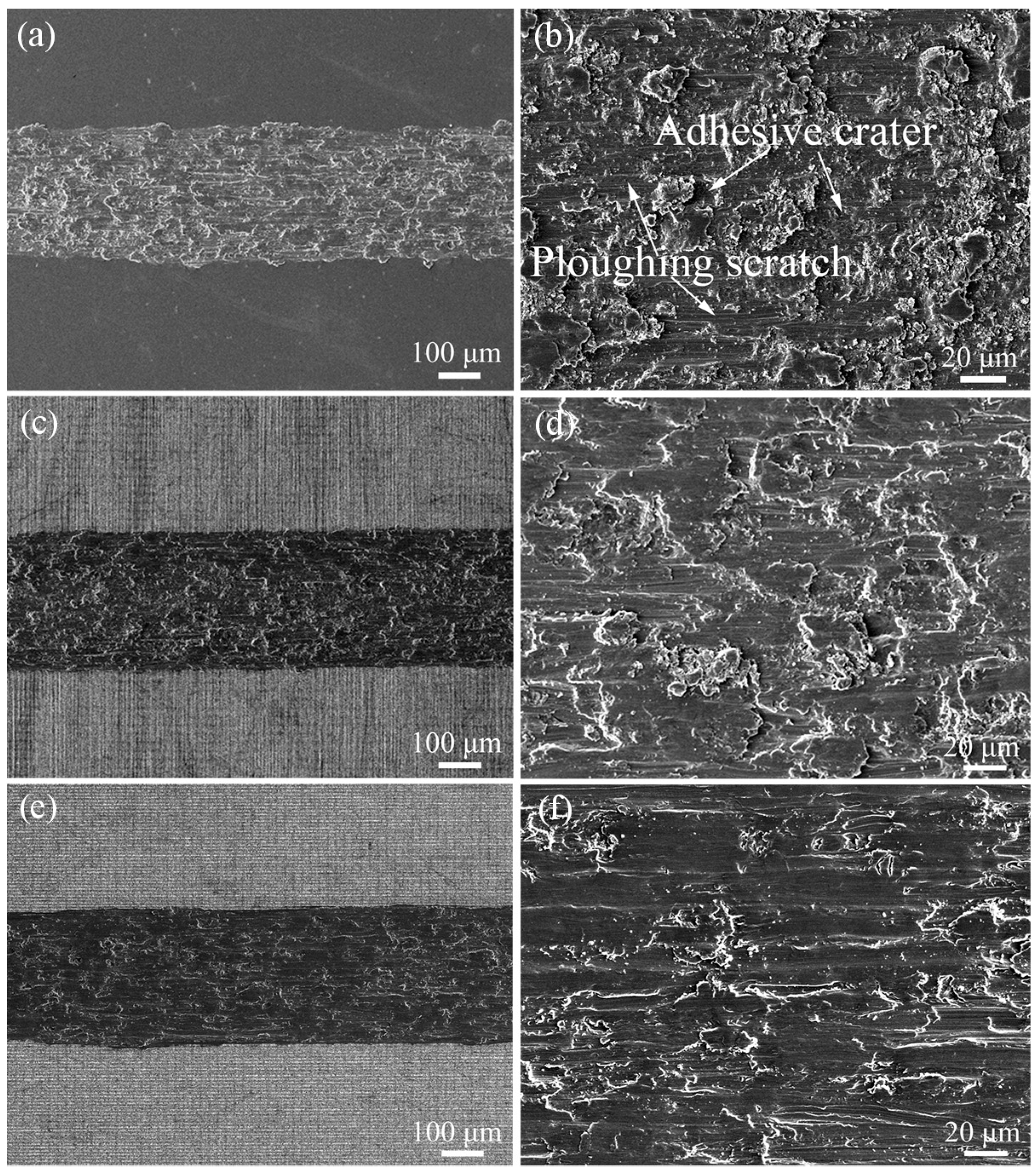
3.3. Effect of LIPSS on Friction Properties Under Starved Oil Lubricated Conditions
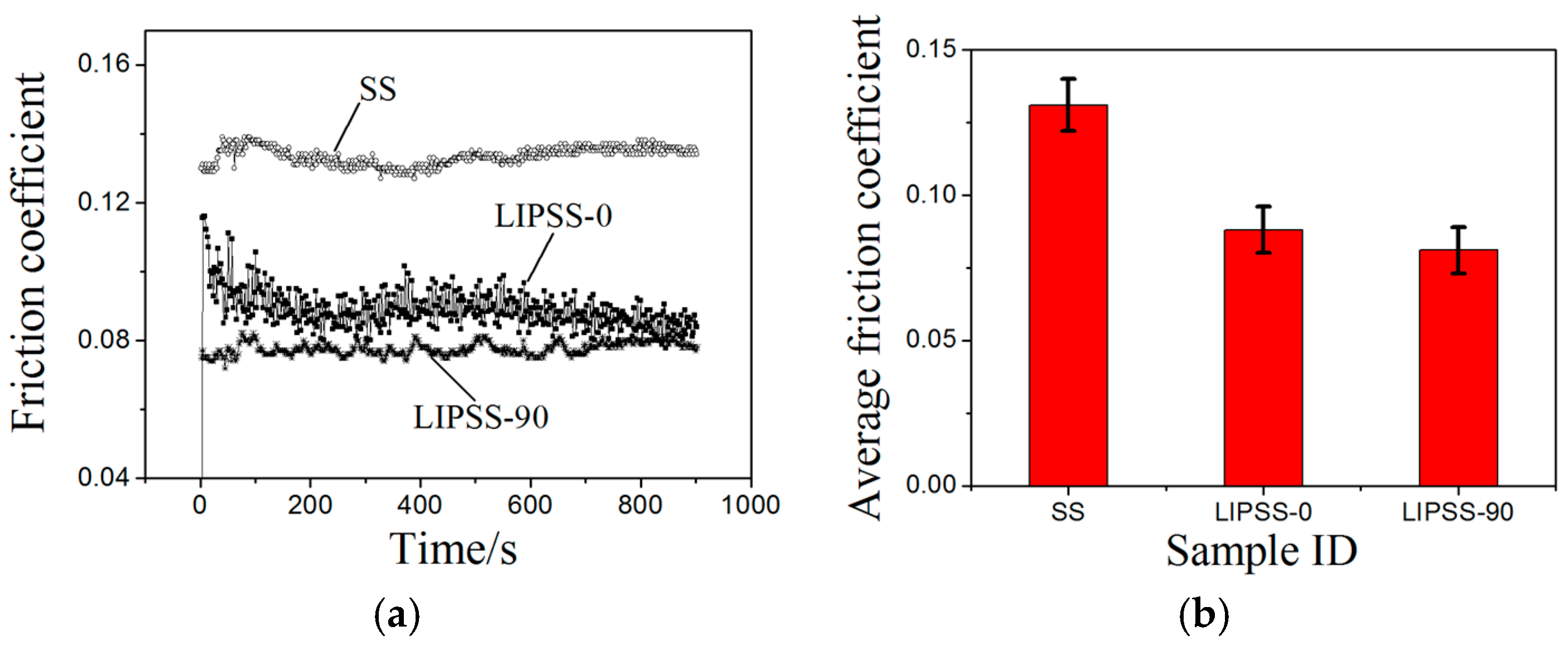
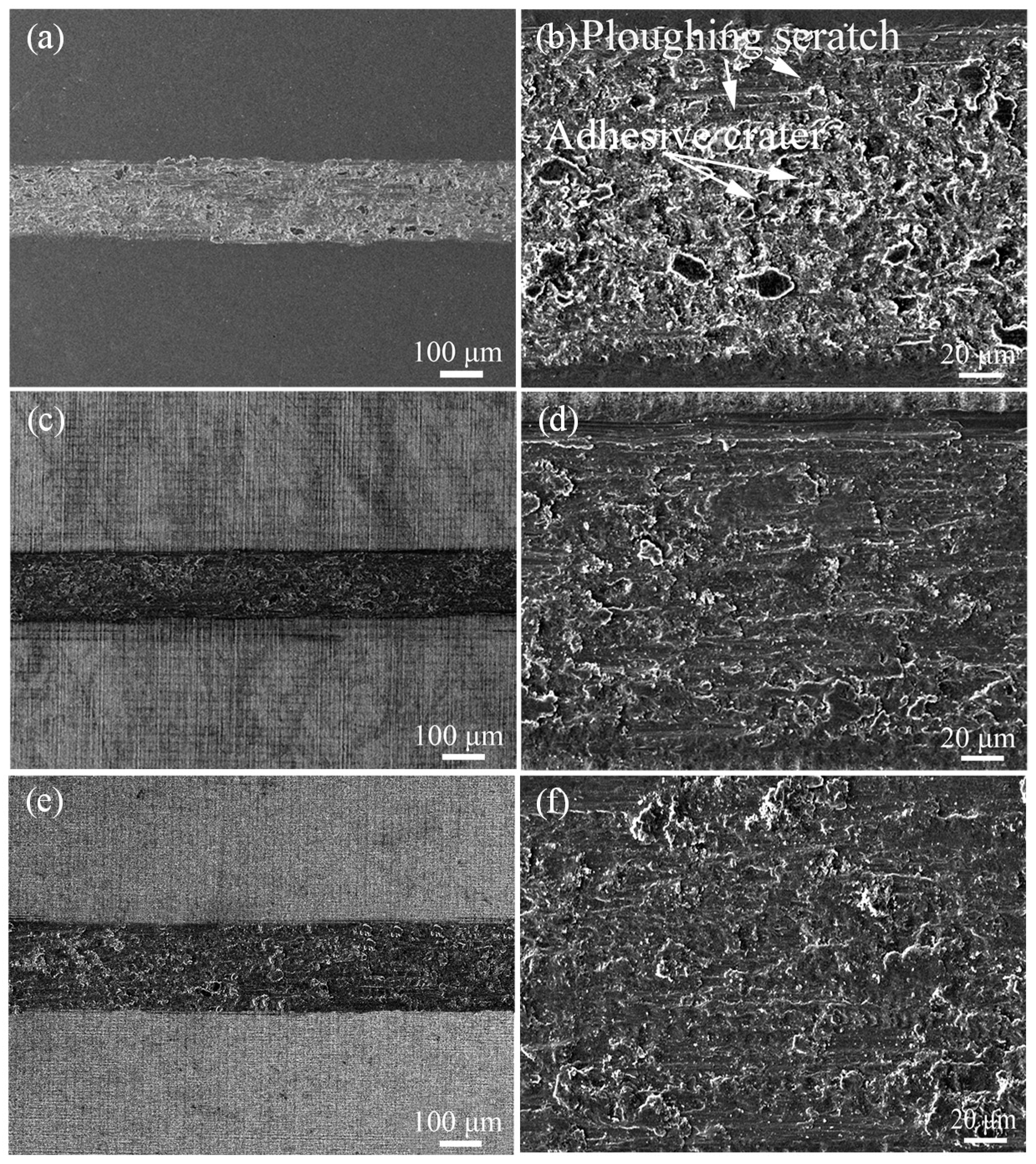
4. Conclusions
Acknowledgments
Author Contributions
Conflicts of Interest
References
- Wan, Y.; Xiong, D.S. The effect of laser surface texturing on frictional performance of face seal. J. Mater. Process. Technol. 2008, 197, 96–100. [Google Scholar] [CrossRef]
- Wu, Z.; Deng, J.X.; Chen, Y.; Xing, Y.Q.; Zhao, J. Performance of the self-lubricating textured tools in dry cutting of Ti-6Al-4V. Int. J. Adv. Manu. Technol. 2012, 62, 943–951. [Google Scholar] [CrossRef]
- Bhushan, B. Nanotribology and nanomechanics in nano/biotechnology. Phil. Trans. R. Soc. A 2008, 366, 1499–1537. [Google Scholar] [CrossRef] [PubMed]
- Xing, Y.Q.; Deng, J.X.; Wu, Z.; Cheng, H.W. Effect of regular surface textures generated by laser on tribological behavior of Si3N4/TiC ceramic. Appl. Surf. Sci. 2013, 265, 823–832. [Google Scholar] [CrossRef]
- Kovalchenko, A.; Ajayi, O.; Erdemir, A.; Fenske, G.; Etsion, I. The effect of laser texturing of steel surfaces and speed-load parameters on the transition of lubrication regime from boundary to hydrodynamic. Tribol. Trans. 2004, 47, 299–307. [Google Scholar] [CrossRef]
- Gualtieri, E.; Borghi, A.; Calabri, L.; Pugno, N.; Valeri, S. Increasing nanohardness and reducing friction of nitride steel by laser surface texturing. Tribol. Int. 2009, 42, 699–705. [Google Scholar] [CrossRef]
- Pettersson, U.; Jacobson, S. Textured surfaces for improved lubrication at high pressure and low sliding speed of roller/piston in hydraulic motors. Tribol. Int. 2007, 40, 355–359. [Google Scholar] [CrossRef]
- Pettersson, U.; Jacobson, S. Influence of surface texture on boundary lubricated sliding contacts. Tribol. Int. 2003, 36, 857–864. [Google Scholar] [CrossRef]
- Wang, X.; Kato, K. Improving the anti-seizure ability of SiC seal in water with RIE texturing. Tribol. Lett. 2002, 14, 275–280. [Google Scholar] [CrossRef]
- He, D.Q.; Zheng, S.X.; Pu, J.B.; Zhang, G.G.; Hu, L.T. Improving tribological properties of titanium alloys by combining laser surface texturing and diamond-like carbon film. Tribol. Int. 2015, 82, 20–27. [Google Scholar] [CrossRef]
- Tagawa, N.; Takada, M.; Mori, A.; Sawada, H.; Kawahara, K. Development of contact sliders with nanotextures by femtosecond laser processing. Tribol. Lett. 2006, 24, 143–149. [Google Scholar] [CrossRef]
- Yasumaru, N.; Miyazaki, K.; Kiuchi, J. Control of tribological properties of diamond-like carbon films with femtosecond-laser-induced nanostructuring. Appl. Surf. Sci. 2008, 254, 2364–2368. [Google Scholar] [CrossRef]
- Kawasegi, N.; Sugimori, H.; Morimoto, H.; Morita, N.; Hori, I. Development of cutting tools with microscale and nanoscale textures to improve friction behavior. Precis. Eng. 2009, 33, 248–254. [Google Scholar] [CrossRef]
- Wu, B.; Zhou, M.; Li, J.; Ye, X.; Li, G.; Cai, L. Superhydrophobic surfaces fabricated by microstructuring of stainless steel using a femtosecond laser. Appl. Surf. Sci. 2009, 256, 61–66. [Google Scholar] [CrossRef]
- Ahsan, M.S.; Ahmed, F.; Kim, Y.G.; Lee, M.S.; Jun, M.B.G. Colorizing stainless steel surface by femtosecond laser induced micro/nano-structures. Appl. Surf. Sci. 2011, 257, 7771–7777. [Google Scholar] [CrossRef]
- Chen, C.Y.; Chung, C.J.; Wu, B.H.; Li, W.L.; Chien, C.W.; Wu, P.H.; Cheng, C.W. Microstructure and lubricating property of ultra-fast laser pulse textured silicon carbide seals. Appl. Phys. A 2012, 107, 345–350. [Google Scholar] [CrossRef]
- Eichstӓdt, J.; Romer, G.R.B.E.; Huis in’t Veld, A.J. Towards friction control using laser-induced periodic surface structure. Phys. Proc. 2011, 12, 7–15. [Google Scholar] [CrossRef]
- Bonse, J.; Koter, R.; Hartelt, M.; Spaltmann, D.; Pentzien, S.; Hohm, S. Femtosecond laser-induced periodic surface structures on steel and titanium alloy for tribological applications. Appl. Phys. A 2014, 117, 103–110. [Google Scholar] [CrossRef]
- Birnbaum, M. Semiconductor surface damage produced by ruby lasers. J. Appl. Phys. 1965, 36, 3688–3689. [Google Scholar] [CrossRef]
- Yasumaru, N.; Sentoku, E.; Miyazaki, K.; Kiuchi, J. Femtosecond-laser-induced nanostructure formed on nitrided stainless steel. Appl. Surf. Sci. 2013, 264, 611–615. [Google Scholar] [CrossRef]
- Pfeiffer, M.; Engel, A.; Gruettner, H.; Guenther, K.; Marquardt, F.; Reisse, G. Ripple formation in various metals and super-hard tetrahedral amorphous carbon films in consequence of femtosecond laser irradiation. Appl. Phys. A 2013, 110, 655–659. [Google Scholar] [CrossRef]
- Zhao, Q.Z.; Malzer, S.; Wang, L.J. Formation of subwavelength periodic structures on tungsten induced by ultrashort laser pulses. Opt. Lett. 2007, 32, 1932–1934. [Google Scholar] [CrossRef] [PubMed]
- Bonse, J.; Rosenfeld, A.; Kruger, J. Implication of transient changes of optical and surface properties of solids during femtosecond laser pulse irradiation to the formation of laser-induced periodic surface structures. Appl. Surf. Sci. 2011, 257, 5420–5423. [Google Scholar] [CrossRef]
- Shen, M.; Carey, J.; Crouch, C.; Kandyla, M.; Stone, H.; Mazur, E. High-density regular arrays of nanometer-scale rods formed on silicon surfaces via femtosecond laser irradiation in water. Nano Lett. 2008, 8, 2087–2091. [Google Scholar] [CrossRef] [PubMed]
- Bian, H.; Yang, Q.; Liu, H.W.; Chen, F.; Du, G.Q.; Si, J.H.; Hou, X. A facile preparation route for netlike microstructures on a stainless steel using an ethanol-mediated femtosecond laser irradition. Mater. Sci. Eng. C 2013, 33, 663–667. [Google Scholar] [CrossRef] [PubMed]
- Mannion, P.T.; Magee, J.; Coyne, E.; O’Connor, G.M.; Glynn, T.J. The effect of damage accumulation behavior on ablation thresholds and damage morphology in ultrafast laser micro-machining of common metals in air. Appl. Surf. Sci. 2004, 233, 275–287. [Google Scholar] [CrossRef]
- Bizi-bandoki, P.; Valette, S.; Audouard, E.; Benayoun, S. Effect of stationary femtosecond laser irradiation on substructures’ formation on a mold stainless steel surface. Appl. Surf. Sci. 2013, 270, 197–204. [Google Scholar] [CrossRef]
- Yasumaru, N.; Miyazaki, K.; Kiuchi, J. Femtosecond-laser-induced nanostructure formed on hard thin films of TiN and DLC. Appl. Phys. A 2003, 76, 983–985. [Google Scholar] [CrossRef]
- Miyazaki, K.; Maekawa, N.; Kobayashi, W.; Kaku, M.; Yasumaru, N.; Kiuchi, J. Reflectivity in femtosecond-laser-induced structural changes of diamond-like carbon film. Appl. Phys. A 2005, 80, 17–21. [Google Scholar] [CrossRef]
- Ardron, M.; Weston, N.; Hand, D. A practical technique for the generation of highly uniform LIPSS. Appl. Surf. Sci. 2014, 313, 123–131. [Google Scholar] [CrossRef]
- Sipe, J.E.; Young, J.F.; Preston, J.S.; van Driel, H.M. Laser-induced periodic surface structure. I. Theory. Phys. Rev. B 1983, 27, 1141–1154. [Google Scholar] [CrossRef]
- Miyaji, G.; Miyazaki, K. Origin of periodicity in nanostructuring on thin film surfaces ablated with femtosecond laser pulses. Opt. Express 2008, 16, 16265–16271. [Google Scholar] [CrossRef] [PubMed]
- Costache, F.; Henyk, M.; Reif, J. Modification of dielectric surfaces with ultra-short laser pulses. Appl. Surf. Sci. 2002, 186, 352–357. [Google Scholar] [CrossRef]
- Jia, T.Q.; Chen, H.X.; Huang, M.; Zhao, F.L.; Qiu, J.R.; Li, R.X. Formation of nanogratings on the surface of a ZnSe crystal irradiated by femtosecond laser pulses. Phys. Rev. B. 2005, 72, 1254291–1254294. [Google Scholar] [CrossRef]
- Dong, Y.; Molian, P. Coulomb explosion-induced formation of highly oriented nanoparticles on thin films of 3C-SiC by the femtosecond pulsed laser. Appl. Phys. Lett. 2004, 84, 10–12. [Google Scholar] [CrossRef]
- Li, K.M.; Yao, Z.Q.; Hu, Y.X.; Gu, W.B. Friction and wear performance of laser peen textured surface under starved lubrication. Tribol. Int. 2014, 77, 97–105. [Google Scholar] [CrossRef]
- Qi, L.T.; Nishii, K.; Namba, Y. Regular subwavelength surface structures induced by femtosecond laser pulses on stainless steel. Opt. Lett. 2009, 34, 1846–1848. [Google Scholar] [CrossRef] [PubMed]
- Kim, D.E.; Suh, N.P. On microscopic mechanism of friction and wear. Wear 1991, 149, 199–208. [Google Scholar] [CrossRef]
- Bathe, R.; Krishna, V.S.; Nikumb, S.K. Laser surface texturing of gray cast iron for improving tribological behavior. Appl. Phys. A 2014, 117, 117–123. [Google Scholar] [CrossRef]
- Dumitru, G.; Romano, V.; Gerbig, Y.; Weber, H.P.; Haefke, H. Femtosecond laser processing of nitride-based thin films to improve their tribological performance. Appl. Phys. A 2005, 80, 283–287. [Google Scholar] [CrossRef]
- Xing, Y.Q.; Deng, J.X.; Zhou, Y.H.; Li, S.P. Fabrication and tribological properties of Al2O3/TiC ceramic with nano-textures and WS2/Zr soft-coatings. Surf. Coat. Technol. 2014, 258, 699–710. [Google Scholar] [CrossRef]
- Rosenkranz, A.; Reinert, L.; Gachot, G.; Mücklich, F. Alignment and wear debris effects between laser-patterned steel surfaces under sliding conditions. Wear 2014, 318, 49–61. [Google Scholar] [CrossRef]
- Yu, C.J.; Yu, H.L.; Liu, G.; Chen, W.; He, B.; Wang, Q.J. Understanding topographic dependence of friction with micro- and nano-grooved surfaces. Tribol. Lett. 2014, 53, 145–156. [Google Scholar] [CrossRef]
- Vihena, L.M.; Sedlacek, M.; Podgornik, B. Surface texturing by pulsed Nd: YAG laser. Tribol. Int. 2009, 42, 1496–1504. [Google Scholar] [CrossRef]
- Shun, P.W.; Zhou, Z.F.; Li, K.Y. Investigation of the tribological properties of the different textured DLC coatings under reciprocating lubricated condition. Tribol. Int. 2013, 65, 259–264. [Google Scholar] [CrossRef]
© 2015 by the authors; licensee MDPI, Basel, Switzerland. This article is an open access article distributed under the terms and conditions of the Creative Commons by Attribution (CC-BY) license (http://creativecommons.org/licenses/by/4.0/).
Share and Cite
Wang, Z.; Zhao, Q.; Wang, C. Reduction of Friction of Metals Using Laser-Induced Periodic Surface Nanostructures. Micromachines 2015, 6, 1606-1616. https://doi.org/10.3390/mi6111444
Wang Z, Zhao Q, Wang C. Reduction of Friction of Metals Using Laser-Induced Periodic Surface Nanostructures. Micromachines. 2015; 6(11):1606-1616. https://doi.org/10.3390/mi6111444
Chicago/Turabian StyleWang, Zhuo, Quanzhong Zhao, and Chengwei Wang. 2015. "Reduction of Friction of Metals Using Laser-Induced Periodic Surface Nanostructures" Micromachines 6, no. 11: 1606-1616. https://doi.org/10.3390/mi6111444
APA StyleWang, Z., Zhao, Q., & Wang, C. (2015). Reduction of Friction of Metals Using Laser-Induced Periodic Surface Nanostructures. Micromachines, 6(11), 1606-1616. https://doi.org/10.3390/mi6111444




